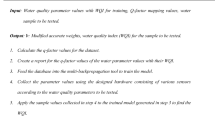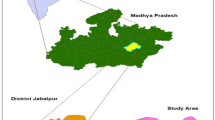Abstract
Drinking water attained from aquifers (ground water) is susceptible to contamination from a wide variety of sources. The importance of ensuring that the water is of high quality is paramount. Multivariate calibration in conjunction with analytical techniques can assist in qualifying and quantifying a wide range of pollutants. These can be divided into two types: inorganic and organic. The former typically includes heavy metals such as cadmium and lead; the latter includes a range of compounds such as pesticides and by-products of industrial processes such as oil refining. This article presents the application of the well known nature-inspired paradigm of artificial neural networks (ANNs) for the quantitative determination of inorganic pollutants (namely cadmium, lead and copper) and organic pollutants (namely anthracene, phenanthrene and naphthalene) from multivariate analytical data acquired from the samples. The success of the determination of the pollutants via ANNs is reported in terms of the overall root mean square error of prediction (RMSEP) which is an accepted measure of the difference between the predicted concentrations and the actual concentrations. The work represents a good example of nature-inspired methods being used to solve a genuine environmental problem.






Similar content being viewed by others
References
Alloway BJ (1990) Heavy metals in soils. Blackie & Son Ltd, Glasgow
Alpizar J, Cladera A, Cerda V, Lastres E, Garcia L, Catasus M (1997) Simultaneous flow injection analysis of cadmium and lead with differential pulse voltammetric detection. Anal Chim Acta 340:149–158
Atkins PW (1992) Physical chemistry. Oxford Press, Oxford
ATSDR (Agency for Toxic Substances and Disease Registry) (1990) Toxicological profile for polycyclic aromatic hydrocarbons. ATSDR, Atlanta
Bessant C, Saini S (2000) A chemometric analysis of dual pulse staircase voltammograms obtained in mixtures of ethanol, fructose and glucose. J Electroanal Chem 489(1–2):76–83
Bianco L, Fontana F, Manca V (2006) P systems with reaction maps. Int J Found Comput Sci 17:27–48
Bishop CM (1995) Neural networks for pattern recognition. Clarendon Press, Oxford
Borba da Cunha AC, Lopez de Alda MJ, Barcelo D, Pizzolato TM, dos Santos JHZ (2004) Multianalyte determination of different classes of pesticides (acidic, triazines, phenyl ureas, anilines, organophosphates, molinate and propanil) by liquid chromatography-electrospray-tandem mass spectrometry. Anal Bioanal Chem 378:940–954
Bowen HGM (1979) Environmental chemistry of the elements. Academic Press Inc., USA
Brereton RG (2003) Chemometrics: data analysis for the laboratory and chemical plant. Wiley, Chichester
Castellini A, Manca V (2009) Learning regulation functions of metabolic systems by artificial neural networks. In: Proceedings of the genetic and evolutionary computation conference (GECCO-2009). ACM Publisher
Castellini A, Manca V, Suzuki Y (2009) Metabolic P-system flux regulation by artificial neural networks. In: 10th workshop in membrane computing (WMC10)
Cauchi M, Bessant C, Setford S (2008) Simultaneous quantitative determination of cadmium, lead, and copper on carbon-ink screen-printed electrodes by differential pulse anodic stripping voltammetry and partial least squares regression. Electroanalysis 20(23):2571–2577
Diaz-Cruz MS, Lopez de Alda MJ, Lopez R, Barcelo D (2003) Determination of estrogens and progestogens by mass spectrometric techniques (GC/MS, LC/MS and LC/MS/MS). J Mass Spectrom 38:917–923
Ferrer R, Guiteras J, Beltran JL (1999) Artificial neural networks (ANNs) in the analysis of polycyclic aromatic hydrocarbons in water samples by synchronous fluorescence. Anal Chim Acta 384:261–269
Goyer R (1991) Toxic effects of metals. Pergamon Press, New York
Greenwood NN, Earnshaw A (1990) Chemistry of the elements. Pergamon Press plc., UK
Hagan MT, Demuth HB, Beale MH (1996) Neural network design. International Thompson Publishing, Boston
Hawkins DM (2004) The problem of overfitting. J Chem Inf Comput Sci 44:1–12
Herrero A, Cruz Ortiz M (1999) Modelling the matrix interference of iron in the multivariate determination of copper by stripping voltammetry: instrument standardization. Talanta 49(4):801–811
Herrero A, Ortiz MC (1998) Modelling the background current with partial least squares regression and transference of the calibration models in the simultaneous determination of Tl and Pb by stripping voltammetry. Talanta 46(1):129–138
Hester RE, Harrison RM (1997) Contaminated land and its reclamation. Royal Society of Chemistry (RSC), Cambridge
Kuster M, Lopez da Alda MJ, Barcelo D (2004) Analysis and distribution of estrogens and progestogens in sewage sludge, soils and sediments. Trends Anal Chem 23(10–11):790–798
Lukaszewski Z, Pawlak MK, Ciszewski A (1980) Determination of thallium and lead in cadmium salts by anodic stripping voltammetry with addition of surfactants to suppress the cadmium peaks. Talanta 27(2):181–185
Manca V (2006) MP systems approaches to biochemical dynamics: Biological rhythms and oscillations. In: Membrane computing, WMC 2006, LNCS 4361. Springer-Verlag, Berlin, pp 86–99
Manca V (2009) Log-gain principles for metabolic P-systems. In: Condon A et al (eds) Algorithmic bioprocesses. Chapter 28, Natural computing series. Springer-Verlag, Berlin
Martens H, Naes T (2001) Multivariate calibration. Wiley, Guildford
Mueller-Hoecker J, Meyer U, Wiebecke B (1988) Copper storage disease of the liver and chronic dietary copper intoxication in two further German infants mimicking Indian childhood cirrhosis. Pathol Res Pract 183:39–45
Murley L (2005) Pollution handbook 2006. National Society for Clean Air and Environmental Pollution, Brighton
Nassehi V, Bikangaga JH (1993) A mathematical model for the hydrodynamics and pollutants transport in long and narrow tidal rivers. Appl Math Model 17(8):415–422
Ni Y, Jin L (1999) Simultaneous polarographic chemometric determination of lead, copper, vanadium, cadmium and nickel. Chemom Intell Lab Syst 45(1–2):105–111
Nordberg GF, Kjelstrom T, Nordberg M (1985) Kinetics and metabolism. CRC Press, USA
O’Neil P (1993) Environmental chemistry. Chapman & Hall, UK
Otto M (1999) Chemometrics: statistics and computer applications in analytical chemistry. Wiley-VCH, Germany
Paun G (2000) Computing with membranes. J Comput Syst Sci 61:108–143
Ribeiro FAL, Ferreira MMC (2005) QSAR model of the phototoxicity of polycyclic aromatic hydrocarbons. J Mol Struct (Theochem) 719:191–200
Richards ECL (2003) A generic method for optimal multivariate calibration of voltammetric data. Cranfield University at Silsoe, UK
Richards E, Bessant C, Saini S (2002) Multivariate data analysis in electroanalytical chemistry. Electroanalysis 14(22):1533–1542
Rodriguez-Mozaz S, Lopez da Alda MJ, Barcelo D (2004) Monitoring of estrogens, pesticides and bisphenol A in natural waters and drinking water treatment plants by solid-phase extraction-liquid chromatography-mass spectrometry. J Chromatogr A 1045:85–92
Rouessac F, Rouessac A (2000) Chemical analysis: instrumentation methods and techniques. Wiley, Chichester
Stollery BT, Broadbent DE, Banks HA, Lee WR (1991) Short-term prospective study of cognitive functioning in lead workers. Br J Ind Med 48:739–749
Stuyfzand PJ (2004) Quantifying the hydrogeochemical impact and sustainability of artificial recharge systems. Artificial Recharge Demonstration Project (EVK1-CT2002-00114), pp 1–10
Thomas P (2003) Metal analysis in chemical analysis of contaminated land. Blackwell Publishing, Oxford
Wang J, Tian B, Wang J, Lu J, Olsen C, Yarnitzky C, Olsen K, Hammerstrom D, Bennett W (1999) Stripping analysis into the 21st century: faster, smaller, cheaper, simpler and better. Anal Chim Acta 385:429–435
Wise BM, Gallagher NB (1998) PLS_Toolbox 2.0. Eigenvector Research Incorporated, WA
Acknowledgement
The financial support of the Artificial Recharge Demonstration Project (ARTDEMO) by the European Union (Project No: EVK1-CT-2002-00114) is gratefully acknowledged.
Author information
Authors and Affiliations
Corresponding author
Rights and permissions
About this article
Cite this article
Cauchi, M., Bianco, L. & Bessant, C. The quantification of pollutants in drinking water by use of artificial neural networks. Nat Comput 10, 77–90 (2011). https://doi.org/10.1007/s11047-010-9185-1
Published:
Issue Date:
DOI: https://doi.org/10.1007/s11047-010-9185-1




